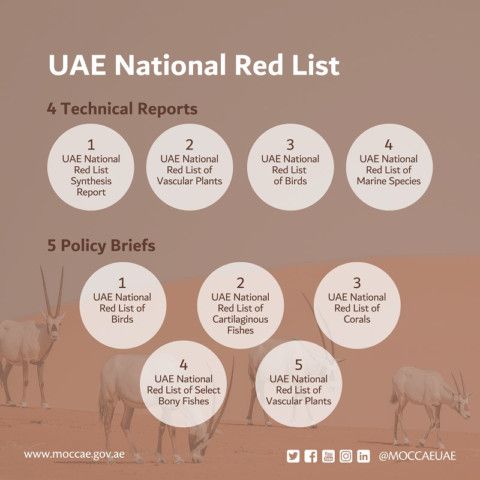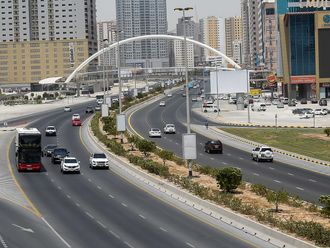
Dubai:The Ministry of Climate Change and Environment (MOCCAE) today issued the UAE National Red List that provides a complete evaluation of the status of wildlife species in the country to measure the effectiveness of current conservation policies and inform future efforts in this space in a bid to achieve the United Nations Sustainable Development Goal (SDG) 14: Life Below Water and SDG 15: Life on Land by 2030.
The project aims to enhance the UAE’s international competitiveness in line with its commitment to meeting its obligations under regional and international conventions and implementing national strategies, such as the National Biodiversity Strategy and the National Climate Change Plan of the UAE 2017-2050.
Risk of extinction
The UAE National Red List project evaluated the risk of extinction for 1,167 species in the country and identified endangered species. The UAE is home to 58 native species of mammals, 39 of which are terrestrial and 19 are marine. Other species of mammals in the country are invasive alien species (IAS). Furthermore, the UAE has 72 species of herpetofauna, including 57 terrestrial reptile species, 13 marine reptile species and two amphibian species, in addition to 167 species of native birds and 598 species of native plants.
The project has also evaluated the status of select marine species, including 126 species of bony fish, 80 species of cartilaginous fishes, and 66 species of corals.
Distribution maps for endangered species were developed to devise conservation plans and programmes for these species and their natural habitats.
Legislative framework
Speaking on the huge undertaking, Mariam bint Mohammed Almheiri, Minister of Climate Change and Environment, said: “Protecting wildlife and ensuring its sustainability is one of the strategic priorities within the UAE’s efforts to preserve the environment. To achieve this objective, we established an integrated legislative framework to sustainably manage and protect wildlife in line with international conventions, such as the Convention on Biological Diversity (CBD) and the Convention on the Conservation of Migratory Species of Wild Animals (CMS).”
She added: “The UAE has an impressive track record in species conservation owing to the guidance and vision of its wise leadership. Our work has contributed to the rehabilitation of multiple endangered species through launching breeding programs and declaring and expanding terrestrial and marine protected areas.”
Mammals
Through studies and surveys, the UAE National Red List project concluded that 46.7 percent of all mammal species in the country are endangered.
Terrestrial mammals
The project monitored a wide variety of terrestrial mammals in diverse environments in the country, and found that carnivores constituted 28.2 per cent, rodents 20.5 per cent, and bats 30.7 per cent of the confirmed native species.
The Arabian tahr is the only endemic species of mammals in the country. In addition, the UAE is home to five species of mammals that are endemic to the Arabian Peninsula — the Arabian oryx, the Arabian gazelle, the sand gazelle, the jerboa and the Arabian rat.
The study showed the extinction of three species of mammals in the wild — the Arabian wolf, the Arabian leopard and the striped hyena.
Marine mammals
The country’s seas are home to a variety of marine mammals that represent a key part of marine wealth — not only locally, but also internationally. There are 18 registered species of cetaceans and one species of sirenians — dugong. In addition, there are major groups of at least four species of marine mammals, including the humpback dolphin. Studies indicate that it is the largest concentration of this species in the world.
Herpetofauna
According to the list, the UAE has nearly 60 species of terrestrial reptiles, including one endemic species — the leaf-toed gecko — and two species of amphibians, in addition to eight species of sea snakes and five species of sea turtles.
Assessments of the status of herpetofauna show that 19 per cent of the reptile species in the country are endangered, while 69 percent are least concern.
Birds
The UAE has 459 bird species, 167 of which were evaluated. Birds in the country are divided into two groups — those that are regularly occurring and those that are resident. Fifty-three per cent of the bird species in the UAE are endangered, while 14 per cent are considered near threatened, and 33 per cent are least endangered.
Plants
The UAE has 945 species of vascular plants and 598 species of native plants were evaluated. Eight per cent of the plant species in the country are endangered, while 62 per cent are near-threatened and 3 per cent are least-endangered.
Collaborative effort
The UAE National Red List project is a collaboration between MOCCAE, the local government authorities across the country, experts from public and private universities, the private sector, and non-governmental organisations (NGOs). It reflects the extensive efforts made by the UAE to conserve its wildlife, in addition to providing valuable data for researchers and academia.












